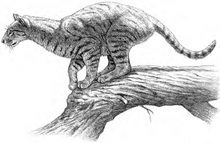Proailurus
Proailurus is an extinct felid genus that lived in Europe and Asia approximately 25 million years ago in the Late Oligocene and Miocene. Fossils have been found in Mongolia, Germany, and Spain.
| Proailurus | |
|---|---|
 | |
| Artist’s reconstruction of Proailurus lemanensis | |
 | |
| Proailurus lemanensis skull | |
| Scientific classification | |
| Kingdom: | Animalia |
| Phylum: | Chordata |
| Class: | Mammalia |
| Order: | Carnivora |
| Suborder: | Feliformia |
| Family: | Felidae |
| Subfamily: | †Proailurinae |
| Genus: | †Proailurus Filhol, 1879 |
| Type species | |
| †Proailurus lemanensis Filhol, 1879 | |
| Species | |
| |
Etymology
The generic name Proailurus comes from the Greek πρό pro, meaning 'before', and αἴλουρος ailuros, meaning 'cat'.
Description
Proailurus lemanensis was a compact and small animal, just a little larger than the domestic cat, weighing about 20 lb (9 kg). It had a long tail, large eyes and sharp claws and teeth, with similar proportions to the modern viverrids. Its claws would have been retractable to some extent. Like the viverrids, Proailurus was at least partially arboreal.[1]
Classification
The genus Proailurus was first described by Henri Filhol in 1879 for fossils found in the Saint-Gerand site in France. He named two species, Proailurus lemanensis, based on a mandible, and Proailurus julieni.[2] However, P. julieni was later placed in the genus Stenogale.[3][4]
In 1882, Filhol described a third species, Proailurus medius.[5] In 1888, Schlosser made "P." medius the type species of the genus Haplogale.[6] Haplogale media's placement was later confirmed by Robert Hunt's 1998 studies of aeluroid skulls.[7]
In 1999, Peigné carried out a systematic review of the genus, naming another two species, P. bourbonnensis and P. major, in the process.[8][9]
Distribution and species
Fossils of Proailurus lemanensis were first found in Saint-Gerand and later in Quercy.[7] Robert Hunt, while measuring fragmentary fossils from Hasanda-Gol in Mongolia, placed a lower jaw fragment as Proailurus sp.,[7] but Peigne placed the fragment in nimravid genus Eofelis instead, which later authors supported,[8][9] although at least one suggested the fragment could be assigned to Pseudaelurus cuspidatus instead.[10]
Several Proailurus-grade fossils have been found in North America, but remain undescribed. These include the Ginn Quarry cat, known from a complete skull, which has dentition similar to Proailurus lemanensis but with a slightly larger skull. Robert Hunt also noted several specimens that he believed belonged to Proailurus-grade felids, including a pair from the Sheep Creek site in Nebraska, one a lynx-sized felid, the other closer in size to a leopard. He also noted a remarkable individual from an East Cuyumungue locality, possibly the same species as the larger Sheep Creek specimen; and another specimen from Echo Quarry.[7] However, the larger Sheep Creek specimen, the East Cayumungue individual, and the Echo Quarry specimen were all assigned to the species Pseudaelurus validus in 2001, and the smaller Sheep Creek material to Pseudaelurus skinneri in 2003.
Evolution
Proailurus is believed to have evolved from earlier ailuroid carnivorans such as Stenogale and Haplogale.[7] It is a likely ancestor of Pseudaelurus, which lived 20-10 million years ago, and probably gave rise to the major felid lines, including the extinct machairodontines and the extant felines and pantherines, although the phylogeny of the cats is still not precisely known.[11]
Proailurus is largely considered to be the first "true" cat and the ancestor of the entire cat family. Most studies support this, placing Proailurus as the basal member of the Felidae.[12][9] One 2005 phylogeny placed it as a basal member of the Feliformia,[13] but later studies do not support this.
References
- Turner, Alan; Antón, Mauricio (1997). The Big Cats and their fossil relatives. New York: Columbia University Press. p. 25. ISBN 978-0-231-10228-5.
- Filhol, Henri (1879). "Etude des mammiferes fossiles de Saint-Gerand le Puy (Allier)". Bibliotheque de l'Ecole des Hautes Etudes, Section des Sciences Naturelles. 19 (1): 1–252.
- Tielhard de Chardin, P. (1915). "Les carnassiers des phosphorites du Quercy". Ann. Pal6ontol. 9 (3, 4): 1–90.
- Viret, J. (1929). "Les faunes des mammiferes de l'Oligocene superieur de la Limagne Bourbonnaise". Ann. l'Univ. Lyon (N. Ser.). 47: 1–328.
- Filhol, Henri (1882). "Memoire sur quelques mammiferes fossiles des phosphorites du Quercy. Ibid": 1–140. Cite journal requires
|journal=(help) - Schlosser, M. (1888). "Die Affen, Lemuren, Chiropteren, Insectivoren, Marsupialier, Creodonten und Carnivoren des Europaischen Tertiars. Beitr. Palaontol. Osterreich-Ungamns". Part II (Volume 7): 225–386. Cite journal requires
|journal=(help) - Hunt, Robert M. (1998). "Evolution of the Aeluroid Carnivora: Diversity of the Earliest Aeluroids from Eurasia (Quercy, Hsanda-Gol) and the Origin of Felids". American Museum Novitates (3252). hdl:2246/3156.
- Peigné, Stéphane (1999). "Proailurus, l'un des plus anciens Felidae (Carnivora) 'dEurasie: systematique et evolution". Cite journal requires
|journal=(help) - Werdelin, Lars; Yamaguchi, Nobuyuki; Johnson, Warren; O'Brien, Stephen J. (2010). "Phylogeny and evolution of cats (Felidae)". In D.W. Macdonald; A.J. Loveridge (eds.). Biology and Conservation of Wild Felids. Oxford University Press. pp. 59–82. ISBN 9780199234455.
- Rothwell, Tom (2004). "New Felid Material from the Ulaan Tologoi Locality, Loh Formation (Early Miocene) of Mongolia". Bulletin of the American Museum of Natural History. 285: 157–165. CiteSeerX 10.1.1.616.5669. doi:10.1206/0003-0090(2004)285<0157:C>2.0.CO;2. ISSN 0003-0090.
- Christiansen, Per (2008). "Phylogeny of the great cats (Felidae: Pantherinae), and the influence of fossil taxa and missing characters". Cladistics. 24 (6): 977–992. doi:10.1111/j.1096-0031.2008.00226.x.
- Rothwell, Tom (2003). "Phylogenetic Systematics of North American Pseudaelurus (Carnivora: Felidae)". American Museum Novitates. 2403: 1–64. doi:10.1206/0003-0082(2003)403<0001:PSONAP>2.0.CO;2. hdl:2246/2829.
- Wesley-Hunt, Gina D.; Flynn, John J. (2005). "Phylogeny of the Carnivora: basal relationships among the Carnivoramorphans, and assessment of the position of 'Miacoidea' relative to Carnivora". Journal of Systematic Palaeontology. 145 (3): 1–28. doi:10.1111/j.1096-3642.2005.00194.x.
.svg.png)